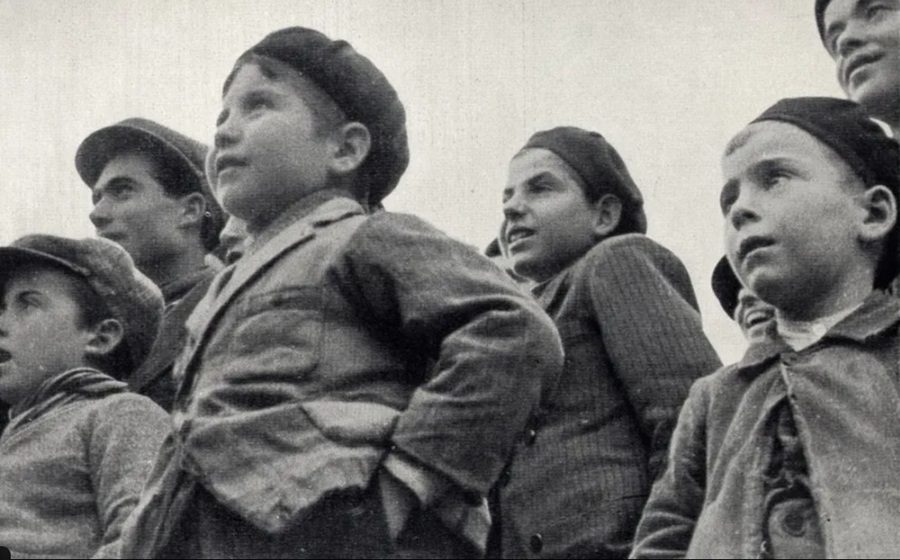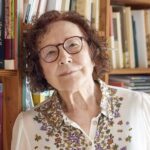- History
- 26 de September de 2025
- No Comment
- 9 minutes read
Sketch of a Utopia: The Misiones Pedagógicas during the Second Spanish Republic

Sketch of a Utopia: The Misiones Pedagógicas during the Second Spanish Republic


Soledad Bengoechea
On 17 December 1931, members of the first mission organised by the Patronato de Misiones Pedagógicas (Board of Pedagogical Missions) arrived in the small Segovian town of Ayllón. Upon reaching the village, these misioneros and misioneras (volunteers, members of the Pedagogical Missions) —as they were known—most of them young, were met with a mixture of reactions: wary or questioning looks, eyes full of surprise, furrowed brows, gestures of curiosity, suspicious glances, expressions of joy, words of welcome, the excited running and jumping of children, and cautious approaches. Photographs, and the occasional surviving documentary film, show us this blend of emotions experienced by villagers at their first encounter with this group of unusual visitors from the cities. The same scene would be repeated in some 7,000 towns and villages that the missions went on to visit.
How did all this come about? One of the defining characteristics of the Second Spanish Republic—alongside its socio-economic reforms favouring the peasantry, workers, and the popular classes—was its determination to eradicate illiteracy and ignorance in a backward and impoverished Spain. It was estimated that out of a population of just over 23 million, some ten million Spaniards, especially in rural areas, were illiterate. It was in this context that, on 29 May 1931, the Misiones Pedagógicas were founded. The initiative had long been nurtured within the Institución Libre de Enseñanza (Free Institute of Education), and above all by Manuel Bartolomé Cossío, director and founder of the Museo Pedagógico Nacional, and a disciple and collaborator of Francisco Giner de los Ríos. Cossío managed to unite intellectuals from diverse backgrounds around a common project focused above all on rural life.
Rodolfo Llopis, then Director-General in the Ministerio de Instrucción Pública, designed and implemented the project. As he himself wrote, the Misiones Pedagógicas had a twofold aim: on the one hand, to bring cultural awareness to Spain’s most remote regions; and on the other, to carry republican values to a traditionalist countryside often hostile to the Republic. As this great pedagogue and politician admitted in April 1931, “The ballot boxes reflect the reality of Spanish society. The great cities are republican, while the countryside clings to tradition”. His objective, and that of many other intellectuals, was clear: to win the countryside for the Republic. Yet this complex task could not fall solely to schools and teachers. Hence the missions were born: “It was necessary to go to the villages and take to them what civilisation creates and which only the cities enjoy”.
Convened by Cossío, president of the Patronato de las Misiones Pedagógicas, between 500 and 700 volunteers from different walks of life came together: teachers, professors, artists, students, and young intellectuals. Among them were the philosopher María Zambrano, the filmmaker José Val del Omar, the poet Luis Cernuda, the playwright Alejandro Casona, the musician Eduardo Martínez Torner, the painter Ramón Gaya, and a vibrant “infantry” from which later emerged figures such as Maruja Mallo, María Moliner, Diego Marín, Rafael Dieste, Antonio Sánchez Barbudo, Pedro Pérez Clotet, or the academic Carmen Conde and her husband Antonio Oliver. Each contributed knowledge from their respective fields, creating a truly interdisciplinary project, most with strong ties to pedagogy.
Poet Juan Ramón Jiménez referred to the volunteers as “sailors of enthusiasm”. Indeed, leading cultural figures such as Antonio Machado, María Luisa Navarro, or Pedro Salinas sought, as recorded in issue 150 of the Gaceta de Madrid, 30 May 1931, “to bring to the people, especially those living in rural areas, the breath of progress and the means to participate in it—in its moral stimuli and in the examples of universal advancement—so that all the villages of Spain, even the most remote, might share in the noble benefits and joys today reserved for the urban centres”.
Cossío himself explained that the work of the Missions embraced three areas:
- The promotion of general culture through the creation of permanent and travelling libraries, film screenings, theatre performances in places without theatres, concerts, a travelling museum, and so forth.
- Pedagogical guidance for rural schoolteachers.
- Civic education, necessary to make the principles of a democratic government comprehensible through talks and public meetings.
To bring to the people—particularly those in rural communities—the spirit of progress and the means to engage with it, through its moral incentives and by example of universal advancement, so that all villages in Spain, even the most isolated, might partake in the noble benefits and joys that, until now, had been reserved for the urban centres.
Perhaps the most significant aspect of the Missions for rural communities, cut off from cultural centres, was the provision of books that the volunteers brought with them and travelling libraries, periodically renewed. By 31 March 1937, some 5,522 libraries had been distributed, comprising over 600,000 books. Their size varied according to the population: villages with fewer than a thousand inhabitants received around 150 volumes; those with between three and ten thousand inhabitants received some 300; while larger towns and cities were given 500 or more. In small villages, however, difficulties arose. If the local politician or landowner opposed the establishment of a public library—often those hostiles to the republican government—the project was difficult to sustain. Local authorities would refuse logistical support (such as premises or equipment), and teachers, generally entrusted with running the libraries, feared reprisals for accepting the “mission”. For this reason, between November 1933, when the right won the elections, and February 1936, when the Frente Popular triumphed, the young misioneros found it increasingly hard to carry out their work.
Moreover, over the course of those years, the Coro y Teatro del Pueblo staged 286 performances, while the Exposiciones Circulantes de Pintura del Museo del Pueblo (Travelling Exhibitions of Painting from the People’s Museum) reached 179 towns.
What became of that great project? Unsurprisingly, the Misiones Pedagógicas were a prime target for Francoist forces. From July 1936 until the end of the war, Franco’s aviation and army systematically destroyed schools, museums, libraries, universities, social centres, and workers’ associations.
As in other spheres of the Republic, exile after 1939 became the fate of many who had taken part in the Misiones. But not all left. The majority endured repression under the new regime: imprisonment, professional purges, or internal exile awaited those men and women who, for a brief but luminous time, had traversed remote villages across Spain, driven by hope and a vision of cultural and democratic renewal.
Source: educational EVIDENCE
Rights: Creative Commons

